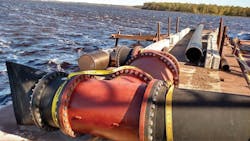Elastomeric Check Valves Streamline Two-Way Water Flow at Ski Area
The Spirit Mountain Recreation Area in Duluth, Minn., provides 175 acres for skiing and snowboarding. Spirit Mountain has its own snowmaking operation that requires approximately 65 million gal of water each year. Previously, the city had used its drinking water system to make snow, but that was determined to be too expensive, limited in delivery rate and an inefficient use of resources.
The city decided to pump water to the recreation area from the St. Louis River. As planning for the pipeline and pumping system began, natural resource managers suggested using the same pipeline to help reduce erosion on a trout stream at the base of the ski area. From spring to late fall, the pipeline would divert a portion of excess storm water generated from the cleared hillside and other development to the St. Louis River. In November and December, it would pump water from the river to Spirit Mountain to make snow.
Planning a reversing pipeline presented several design challenges. Water used for making snow is pumped at up to 6,000 gal per minute. Storm water then flows out of the pipeline at up to 20 cu ft per second. To allow water to flow in both directions, an elastomeric check valve system was designed.
At the end of the 36-ft pipeline, the planning team decided to use a Proco ProFlex Style 710 duckbill check valve and a ProFlex Style 780 wafer-style inline rubber check valve. The valves work automatically, with water flowing out through the duckbill check valve and in through the inline check valve. This system was placed in 20 ft of water about 800 ft from the riverbank, making it only accessible to divers and marine construction crews. Using a product that was reliable and required no maintenance was crucial.
The project was completed and launched in November 2015. The duckbill check valve is drip-tight when needed to prevent backflow. For uphill pumping, the inline rubber check valve allows for little headloss when water is drawn in. During uphill pumping, the water level in the shorewell drops 1 ft. Less than half that loss is attributed to the check valve; the remainder is caused by the inlet screen, fittings and pipeline.


